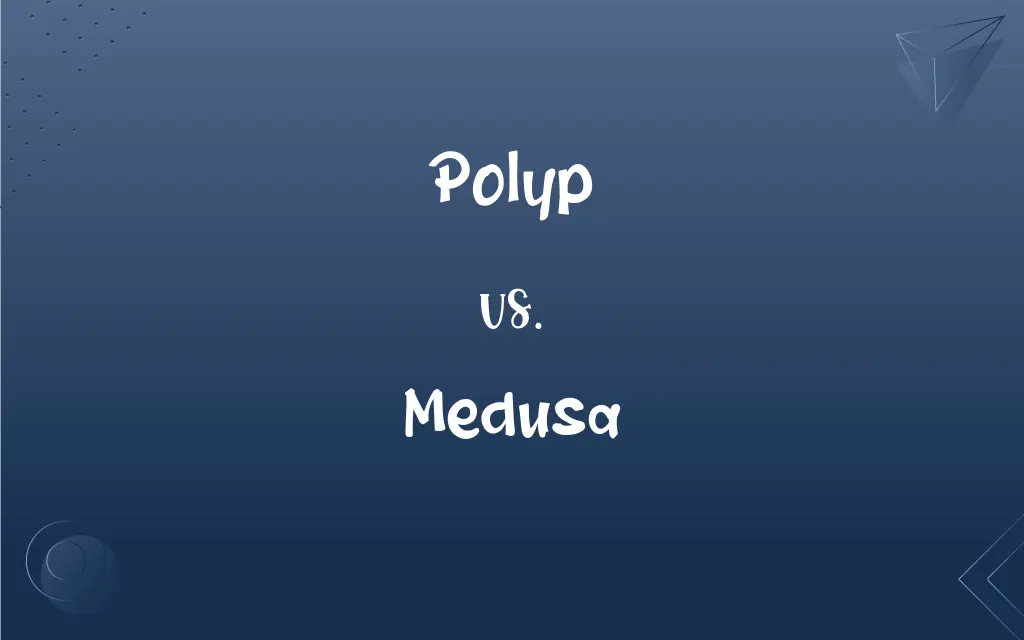Polyp vs. Medusa: What's the Difference?
Edited by Aimie Carlson || By Harlon Moss || Updated on October 28, 2023
Polyp is a sessile, tubular cnidarian life form, while medusa is a free-swimming, bell-shaped stage in cnidarians.

Key Differences
Polyps are typically cylindrical, attached to a substrate, and have a mouth surrounded by tentacles at one end. Medusae, on the other hand, are bell or umbrella-shaped and free-floating, with tentacles hanging down from the bell.
The polyp stage is often involved in colony formation in species like corals. Medusae are typically solitary creatures, drifting individually in open waters.
Polyps are generally found in shallower, more stable water environments. Medusae are adapted to a more pelagic, or open ocean, lifestyle, capable of navigating through different water layers.
Some cnidarians, like jellyfish, exhibit both polyp and medusa stages in their life cycle, representing two distinct forms of the same organism.
Comparison Chart
Shape
Cylindrical and sessile
Bell-shaped and free-swimming
ADVERTISEMENT
Reproduction
Asexual (budding, fragmentation)
Sexual (gametes)
Lifestyle
Often colonial
Solitary
Habitat
Shallow, stable environments
Open ocean, various depths
Movement
Attached, non-motile
Free-floating, motile
Polyp and Medusa Definitions
Polyp
Polyp is an asexual stage in some cnidarians.
The polyp phase is crucial for the growth of jellyfish populations.
ADVERTISEMENT
Medusa
Medusa is a sexually reproducing stage in cnidarians.
The medusa released gametes into the water, initiating the reproductive cycle.
Polyp
Polyp refers to a tubular organism attached to a substrate.
The aquarium tank was adorned with colorful sea anemones, which are polyps.
Medusa
Medusa is a free-swimming cnidarian stage.
The jellyfish displayed its medusa form, elegantly moving through the water.
Polyp
Polyp indicates a non-motile cnidarian form.
Despite being non-motile, polyps can form large, complex structures.
Medusa
Medusa refers to a bell-shaped aquatic organism.
The medusa pulsated rhythmically as it navigated the ocean currents.
Polyp
Polyp is a sessile life form in cnidarians.
Coral reefs are formed by colonies of polyps.
Medusa
Medusa describes an organism with hanging tentacles.
The medusa used its long tentacles to capture prey.
Polyp
Polyp describes an organism with a mouth surrounded by tentacles.
The polyp captured tiny fish using its tentacles.
Medusa
Medusa indicates a motile life form in the open ocean.
Medusae are well-adapted to a nomadic life in the vast ocean.
Polyp
A body form of a cnidarian, such as a hydra or coral, that is cylindrical in shape, has a mouth usually surrounded by tentacles at one end, and is often attached to something at the other end.
Medusa
The Gorgon who was killed by Perseus.
FAQs
What does medusa refer to?
A free-swimming, bell-shaped stage in cnidarians.
Can cnidarians have both polyp and medusa stages?
Yes, many cnidarians have both life stages.
Are medusae always solitary?
Typically, but there are exceptions.
Where are polyps usually found?
In shallow, more stable water environments.
What is a polyp?
A sessile, tubular cnidarian life form.
How do polyps reproduce?
Through methods like budding.
What is the primary reproduction method for medusae?
Sexual reproduction, producing gametes.
Do medusae feed on plankton?
Yes, many feed on plankton and small fish.
Can polyps and medusae exist independently?
Yes, in some species they are independent life stages.
Do all jellyfish exhibit a medusa stage?
Most, but not all jellyfish species have a medusa stage.
Are coral reefs formed by polyps?
Yes, they are formed by colonies of polyps.
Can medusae be found in deep ocean?
Yes, they can navigate through various water layers.
Do polyps have tentacles?
Yes, they have tentacles around their mouth.
Are all medusae bell-shaped?
Most are, but there can be variations.
Can medusae be harmful to humans?
Some can be, due to their stinging cells.
Are sea anemones polyps?
Yes, sea anemones are a type of polyp.
Are polyps visible to the naked eye?
Yes, though some can be quite small.
How do medusae move?
They pulsate their bell-shaped bodies to swim.
Can polyps move?
No, they are attached and non-motile.
Do polyps contribute to marine ecosystems?
Yes, significantly, especially in reef-building.
About Author
Written by
Harlon MossHarlon is a seasoned quality moderator and accomplished content writer for Difference Wiki. An alumnus of the prestigious University of California, he earned his degree in Computer Science. Leveraging his academic background, Harlon brings a meticulous and informed perspective to his work, ensuring content accuracy and excellence.
Edited by
Aimie CarlsonAimie Carlson, holding a master's degree in English literature, is a fervent English language enthusiast. She lends her writing talents to Difference Wiki, a prominent website that specializes in comparisons, offering readers insightful analyses that both captivate and inform.































































